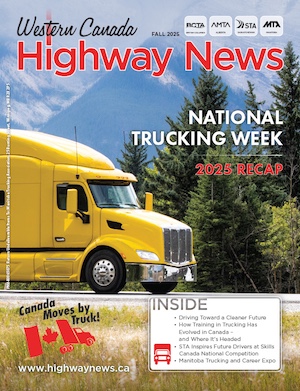Saskatchewan Trucking Association
How to Save Fuel, Reduce Emissions and Enhance RFPs with Next-Generation Retreads
At the back of the Kal Tire retread plant in Regina, SK, a dozen 11R22.5 tires are being rolled off the shipping dock and onto a Kal transport truck. As the driver straps the retreads, which could be any brand-new long-haul steer tires, you hear the rattle of other heavy trucks and buses passing on the Trans-Canada Highway, making daylight.
“These days, you really have to make every hour and every dollar count,” says Norm Schmidt, Director of Retreading, Kal Tire. “Retreading has always been a solid alternative to new tires, but with the price difference and what we can do now with application-specific tread designs, we’re seeing a lot more owner-operators doing the math on how much they can save.”
The savings aren’t just on gas. Retreading also brings significant carbon emissions savings – and the chance to tick one more box on requests for proposals (RFPs) for large companies striving to demonstrate sustainability.
Retreading a medium truck tire requires only 26 litres of oil, while 83 litres are used to manufacture a comparable new tire.
The energy saved in retreading one truck tire is enough to power an average home for an entire month. In addition, every time a company chooses a Kal Tire retread – compared to buying a new, single-use tire – they reduce their CO2 emissions by up to 75%.
On a 11R22.5 retread tire, like the ones about to leave Regina to head back to Kal Tire stores across the Prairies, there’s also a reduction in steel (5 kg), carbon black (5 kg), and rubber (almost 10 kg) – and the chance to divert scrap tires from landfills.
“Retreading is good for the environment, and, fortunately, it’s also good for the wallet,” says Schmidt.
For most retreads, the sticker price is about 50% less than comparable new tires – and yet, retreadable quality casings given a second or third life can run for nearly as many hours as a new tire. This significantly reduces the total cost of tire investment and also leads to savings in fuel economy.
“If you start with a casing designed to be low rolling resistance (requiring less fuel to move the tire), and you retread it, you continue to use less fuel – and that goes a long way for long haulers,” says Schmidt. He started out at one of Kal Tire’s world-class retreading plants (there are 11 across Canada) in BC in the 1980s and has watched the technology evolve in delivering ever-more sophisticated, high-performing retreads. He’s also watched as the companies employing transport contractors place more and more emphasis on reducing their carbon footprint.
“When transportation contractors are competing for contracts from the big companies in potash, lumber, or oil and gas – being able to say you retread and reduce emissions by 75% with every tire on your truck is a pretty cost-effective and environmental way to stand out and stay competitive.”
To learn more about retreading technology, emissions savings, and performance, book a plant tour or
talk to a Kal Tire representative, visit
https://commercial.kaltire.com/retread.


 1-866-985-9791
1-866-985-9791



